Taj 5 in real danger from dry polluted Yamuna | Taj Mahal real danger
Agra: Till recently it was a mere conjecture, but now signs of stress and physical distortions on the white marble surface are beginning to confirm what everyone has been fearing for a long time - the Taj Mahal is in real danger from the dry and polluted Yamuna.
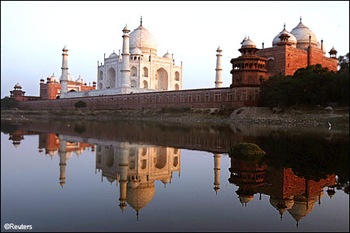
"It's simple, plain and logical to suggest that the Taj Mahal cannot remain in good health for long if its sustaining force, the river Yamuna, is in poor condition," declares R. Nath, whose latest book on the Taj, India's iconic tourist destination and a World Heritage monument, explains the developing scenario in detail.
Experts in the Archeological Survey of India (ASI) have all along been downplaying the threats from the dry and polluted river.
Entry to the chambers in the foundation of the huge edifice has been sealed for years and no independent agency has carried out extensive surveys that could reassure and allay the fears expressed by doomsday forecasters like Nath.
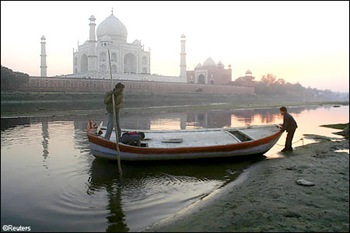
ASI officials refuse to entertain questions about the state of the Taj's foundation. However, a senior ASI official, who preferred not to be named, confided that cracks in the foundation were noticed some years ago and that they had been repaired.
"The cracks were not small, they were big," he said.
Raman, a member of the Supreme Court monitoring committee, said: "I have heard reports about ant-hills and termite colonies in the basement of the Taj Mahal."
The controversial Taj Corridor project - construction of a corridor on the river bed - left the monument in the lurch and the artificially developed park in the rear has permanently distanced the Yamuna from the Taj Mahal, fundamentally altering the physical conditions of the whole complex.
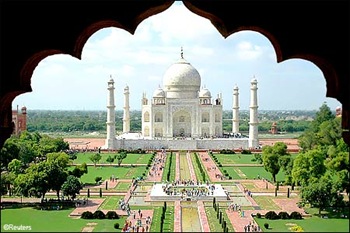
This was against the categorical directive of the S. Varadarajan committee, which said there should be no tinkering with the physical conditions around the monument, an activist said.
Shravan Bharti, a conservationist, said "they (the authorities) are playing with the safety of the Taj Mahal."
R.K. Dixit, the official in charge of the Taj Mahal, confirmed that from the main gate to the central white marble dome the distance is 300 metres. Also, from Mehtab Bagh across the river to the Taj Mahal, the distance is exactly 300 metres."
This means the river was central to the overall design of the whole complex, stressed Rajan Kishore, who has been organising action programmes and fasts for the river Yamuna's protection from pollution.
"If one part of the body is sick and paralysed how can one say the monument is healthy and in good shape?" he asked.
According to Surendra Sharma, president of the Braj Mandal Heritage Conservation Society, the sand blowing in from the dry Yamuna and tonnes of desert sand coming with the westerlies have been a cause of concern for long.
Both V.K. Shukla of the Central Pollution Control Board and B.B. Awasthi of the UP State Pollution Control Board confirm that the soot and dust in the air around the Taj Mahal continues to remain alarmingly high. The dry river bed could be a contributing factor, they said.
However, "the Agra air is much cleaner and safer now with the sulphur dioxide level gone down significantly," insisted one official.
The level of finer sand particles is much higher than the normal but can be brought down if there is water in the river, scientists of the pollution board said.
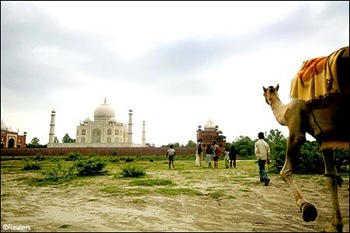
Author Nath is particularly concerned about the use of Fuller's Earth to whiten the Taj's marble surface. Fuller's Earth is widely used in Europe as a bleaching agent before the shearing of sheep.
"In the beginning it was once in several years, but lately it's every now and then. They misled public opinion by calling it "Multani Mitti." Only later it was discovered that they were importing Fuller's Earth. The original "Vajra Lep," the polish on the white marble, did not require any further treatment and should have been left undisturbed," Nath told IANS on phone from Ajmer.
The extensive use of saline or brackish water from the Yamuna has also affected the monument's surface, said Vishal, an environmentalist and photographer.
The question to the ASI is simple, says Nath. "Was a dry Yamuna in the original plan of Shah Jahan (the Mughal emperor who built the monument in memory of his wife Mumtaz Mahal). If the river was integrated in the original plan, for the Taj Mahal's safety and for the scenic ambience it provides, is the objective fulfilled by the dry and polluted river?" he asked.
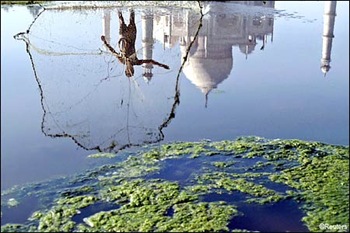
No comments:
Post a Comment